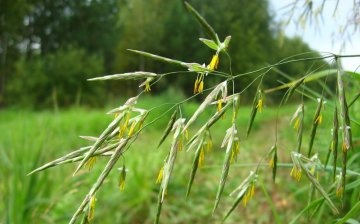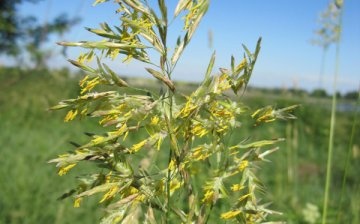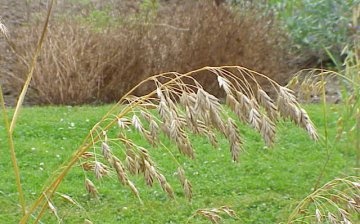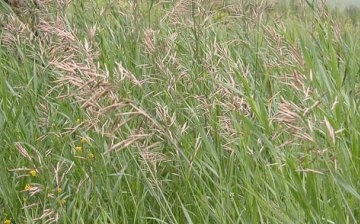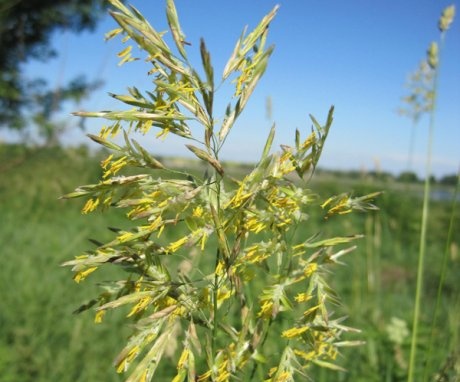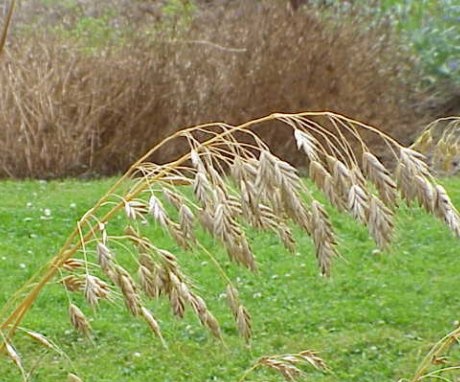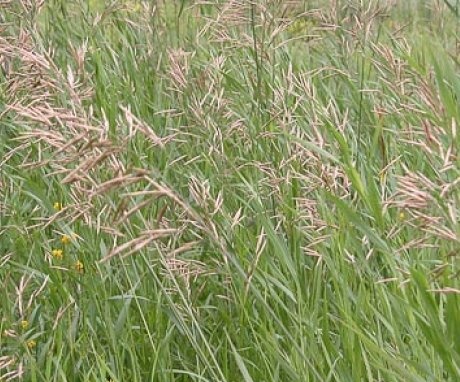Awnless bonfire: growing in pastures and harvesting
Awnless bonfire is a valuable forage crop that is well eaten by animals and is actively used in the preparation of hay. It is a rhizome perennial grass with a wide habitat, which can be easily found on black soil, in forest and forest-steppe waters. Awnless bonfire grows in Central Russia, Bashkiria, Chelyabinsk, Orenburg and other regions. It can be seen in gardens, parks, meadows, fields, and any open area.
Content:
General description of awnless rump
Awnless bonfire - it is a perennialwith a powerful long rhizome.
In nature, the fire grows in large colonies, forming a continuous sod:
- The stem has a height of 60 to 100 cm and is highly leafy.
- Long leaf blades are dark green in color, flat and linear with rough edges.
- In spring and autumn, when the heat is insufficient, the leaves can be very pale in color.
- The inflorescence is a large panicle, its length can reach 35 cm.
- When flowering, it is spreading, and after it is one-sided.
- On spikelets there are from 5 to 10 flowers, several pointed to the top.
According to its external features, the fire is very often confused with wheatgrass, since both of these plants have a similar system of vegetative reproduction.
The rump spreads with the help of its powerful rhizome, which gradually grows and captures all new territory. Young roots give fresh shoots, and young plants with stems, leaves and spikelets grow back. Thanks to such a breeding system and rapid growth, the awnless fire is one of the most adaptable and hardy plants.
It has the following important properties that a gardener must consider:
- Frost resistance. The rhizome of this plant calmly hibernates under a layer of snow, even prolonged severe frosts will not be able to destroy it.
- As soon as the temperature becomes more favorable and the snow melts, the fire will quickly sprout young shoots and grow back in its old place.
- Ability to tolerate flooding. The flood also does not pose a serious threat to the rump if the water stays for up to 60 days. Subsequently, young rhizomes will quickly begin to sprout.
- Ability to withstand repeated mowing. This is one of the most valuable of its features, which provided it with a high demand for quality fodder crop... A bonfire can grow in one place for many years, despite the fact that it will be mowed two or more times in 1 season.
Raising the awnless bonfire
In nature, an awnless bonfire chooses loamy or sandy loam soils, it does not like peat soil or soil with high acidity.
This is a rather drought-resistant plant, capable of tolerating even a strong lack of moisture due to a developed and powerful root system. The best for growing are the soils of coastal valleys near large rivers, the fire also grows well in drained swamps. This plant is not suitable for growing on saline soils only.
The most common varieties widely used for crops are:
- Kozarovitsky.
- Poltava 30.
- Vyshgorodsky.
- Dneprovsky and some others.
Reproduction:
- Before sowing, the seeds need air-heat treatment, which is carried out for 5-10 days.
- After that, they are treated with special compounds that prevent the growth of microbes and mold.
- The fire is usually sown in the spring. together with the spring or in the fall together with winter crops.
- If rump is supposed to be used for seeds, then wide aisles are left on the field - up to 60-70 cm.
- The first shoots begin to appear in May, early April, in June the fire begins to bloom.
Flowering can be batch or explosive, when a large number of inflorescences appear. It will be possible to harvest seeds by direct combining when the spikelets turn brown. They will ripen for about 8 months after inflow, after which they will be completely ready for sowing. As a fodder plant, the fire is sown together with alfalfa and wheatgrass; grasses are eaten by cattle and small ruminants.
Hay must be harvested during the period of throwing the panicles, and it is impossible to be late with harvesting, as this will negatively affect the nutritional value of the hay.
The value of the awnless fire as a fodder crop is very high: 100 kg of ready hay will correspond to 57 fodder units, this mass contains almost 6 kg of digestible valuable protein. The best indicators of the yield of the fire are observed 2-3 years after planting. A perennial plant in nature can grow up to 20 years, with regular mowing, its life can reach 8 years.
Plant care recommendations
Although the bonfire is a very unpretentious plant, it must be grazed at strictly defined periods in order to prevent depletion of the rhizomes.
Although it grows very quickly, it is recommended to use the field for pasture only from the third year after sowing, in order to allow time for the formation of dense turf. Otherwise, animals can simply trample the crops, and because of the compaction of the soil, the fire will not be able to recover.
In addition, there are a few more rules:
- Rump grazing is allowed no more than 3 times in one season, while the height of the aboveground mass must be at least 6 cm, otherwise it will be difficult for the plant to recover.
- It is impossible to graze the rump in late autumn, as in this case photosynthesis will deteriorate, and the rhizomes will not have time to store nutrients. After that, there will be few shoots next year, and it must take several years for the plant carpet to fully recover.
- The bonfire tolerates drought well, but does not like the proximity of groundwater. Because of this, when choosing a planting site, it is better to determine the places in which the aquifer is located deep. A strong root system will still allow the fire to get enough moisture, and the roots will not start to rot.
- The bonfire can be used for making hay and for pasture, but in the second case, the seeds can begin to fall out quickly. This plant is quickly eaten and just as quickly restores green mass, which is why it is so highly valued. It is known that it was actively used as forage grass many centuries ago, and in old sources it is characterized as the best plant for cows and sheep.
Currently, active breeding work continues on the development and regionalization of new varieties. The bonfire is becoming more and more adapted for areas with unfavorable climates, which can ensure its even wider use.
More information can be found in the video.



